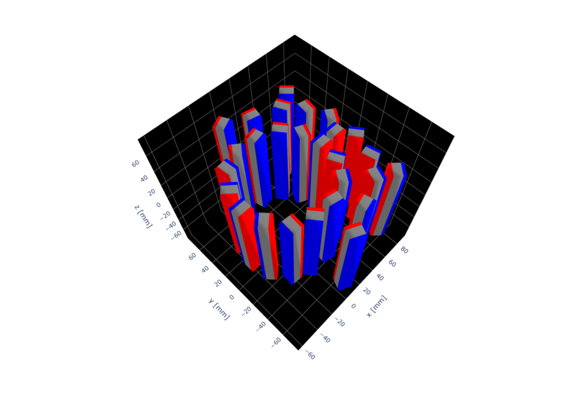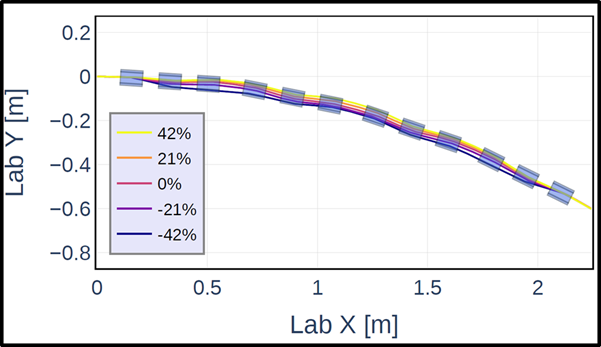TURBO: A novel beam delivery system for charged particle therapy

Charged particle therapy is a well-established modality of cancer treatment and is increasing in worldwide presence due to improved accelerator technology and modern techniques.
The beam delivery system determines the overall timing and beam shaping capabilities, but is restricted by the energy variation speed, which is determined by the energy layer switching time (ELST).

Beamline design with different orbit trajectories over the full momenta range. Credit: J. Yap
Beamlines at treatment facilities have a ±1% momentum acceptance range, requiring all the magnetic fields to adjust to deliver different energy beams at multiple depths in the tumour volume.
Minimising the ELST can enable the delivery of faster, more effective and advanced treatments but requires an improved BDS. A possibility for this could be achieved with a design using Fixed Field Alternating Gradient (FFA) optics, enabling a large energy acceptance to rapidly transport beams of varying energies.
Former OMA fellow Jacinta Yap, together with colleagues from the University of Melbourne and the University of Manchester have developed a novel beam delivery system to explore the potential of rapid depth scanning in charged particle therapy.
The system TURBO (Technology for Ultra Rapid Beam Operation) is a scaled-down proof-of-concept demonstrator adapted for low energy protons. TURBO comprises several interchangeable modules adapted for the University of Melbourne low energy ion ‘Pelletron’ accelerator.
Alongside development of the scaled-down TURBO beamline, work is underway towards a full clinical energy design for transportation of heavier ions.
The modularity of TURBO allows the flexibility to explore and iterate between different concepts: further experimental, simulation and design work will progress the development of a laboratory implemented demonstrator, to improve beam delivery for existing and future clinical charged particle therapy facilities.
Jacinta Yap and her colleagues have carried out simulation studies as well as characterisation measurements to determine realistic parameters for beam transport and particle tracking modelling.
The results, and considerations for implementing TURBO in a clinical setting, were presented at IPAC 2022 and 2023.
More information:
- S. L. Yap, S. L. Sheehy, A. F. Steinberg, H. X. Q. Norman and R. B. Appleby, “TURBO: A novel beam delivery system enabling rapid depth scanning for charged particle therapy”, Journal of Physics: Conference Series 2420, 012094 (2023). https://doi.org/10.1088/1742-6596/2420/1/012094
- S. L. Yap, S. L. Sheehy, A. F. Steinberg, H. X.Q. Norman, R. B. Appleby, S. J. Clarke, “Progress toward TURBO: A novel beam delivery system for charged particle therapy”, 14th International Particle Accelerator Conference, Venezia, JACoW Publishing. https://doi.org/10.18429/JACoW-IPAC-23-THPM091